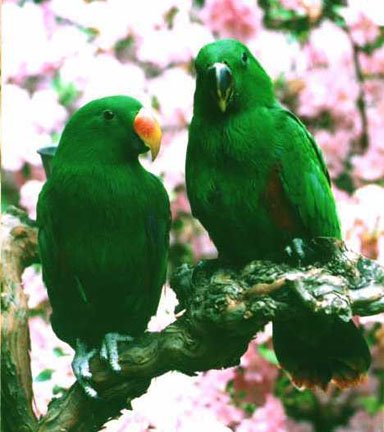|
|||||
|
Papa Kelly & Baby Jerome |
Aruensis
Red-Sided Eclectus Males
One of the most interesting things about Eclectus is the way that the beak color changes from hatch to maturity. A newborn baby has a pinkish beak. As they grow, the beak darkens considerably. The beak of a male baby is almost black at 2 months, with a slight gold tip. As time passes, it lightens and brightens until by the age of about a year, most of the black disappears. The brightness of the color of the beak is an indicator of the overall health of the bird. The beak of the female at two months also is dark with some gold, but it becomes jet black by the age of maturity. There are 10 or more
subspecies of Eclectus Parrots, all strikingly beautiful, from the
South Pacific. They are an Asian parrot that has been around for
10,000 years. Most other parrots have been in existence for only
3,000 years. Their natural habitat is low-lying plains, especially
tropical rain forests. When food is abundant, Eclectus parrots gather
in large flocks, forage together, and live in colonies. This accounts
for them being a wonderfully social bird. The two sexes of this species, unlike those of any other parrot, differ dramatically in color. The females, depending on the variety, are a spectacular combination of red, purple, maroon, blue and yellow; the males are almost entirely green, with red under the wings and on the side of the body, with a touch of turquoise on top of the "shoulders". Both the males and females can learn to talk clearly and distinctly, and develop a very animated personality and charm of their very own. If taught to speak, they will not develop the annoying tendency to screech which is exhibited by other types of large birds. Instead, they will entertain you spontaneously with a hysterical monologue of every phrase they know, complete with inflections and melodious tones that they come up with all by themselves. |
